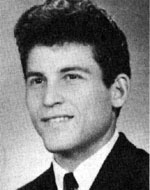Wiesenberg, Yitzhak (“Itzik”)
Son of Jacob and Zivia. He was born on December 31, 1942, in Kfar Sava. When he reached school age he entered the Bar-Ilan religious school. Then, under the influence of the sages and rabbis at the Chabad Yeshiva, Yitzhak entered the Chabad school in Kfar Saba and studied there for several years. In 1952, Yitzhak returned to the Bar-Ilan school after receiving a prize for excellence in his exams. After receiving a certificate of completion was influenced by Bnei Torah to move to “sitting”. He agreed and went to the Chabad yeshiva, but two days later he fled home without explanation – and on this step was a miracle and a salvation for Yitzhak, because that evening the “yeshiva” was attacked by infiltrators who killed a rabbi there. , A resident of Kfar Sava, and many of his friends who studied with him at the Chabad school. His hobby was sports. Upon receiving the certificate of completion of the elementary school, he was admitted to the “Kfar Batya” institution in Ra’anana, to the religious high school vocational school. When he graduated, he began working as a mechanical locksmith in the garage. He was honest with himself, with his friends and with all his knowledge, as he had been educated in the various schools in which he had studied. He was also educated in the Bnei Akiva youth movement, as was the son of veterans of the Torah v’Avodah movement. All his acquaintances recognized him for his goodness and kindness. He was pleasant and liked by all his family, his fiancee and his acquaintances. The father’s illness and his slumber to his deathbed for most of his life and the descent to shelters during the War of Independence made it difficult for Yitzhak and his brothers, who grew up under the supervision of the mother and with the help of grandparents. But they stood the test of time. That’s how the years went until February 1961, when Yitzhak was drafted into the IDF and volunteered for the paratroopers, and he did not say much about his training or parachutes, nor did he discover that one of the parachutes was hit in the leg. He was shocked by the Civil Defense Service and refused to accept the proposal. The medical treatment raised his “profile” but the paratroopers refused to return it. When he was released from the army he returned to work. When the days of alert before the Six-Day War came, he was shocked that he had not been called to the flag while all his comrades had already been recruited. He repeatedly tried to penetrate the paratroopers, but they rejected him by saying, “When we have to – we’ll call you!” When the tension increased and the number of raisings increased, Yitzhak succeeded in returning to one of the paratroop units, and it occurred to him. He participated in the liberation of East Jerusalem and the Rockefeller Museum, and was one of the first paratroopers to arrive at the Western Wall. When he received the reserve duty in Kislev he returned to the unit and on December 21, 1967 he fell in an enemy squadron attack on an observation post near the Damia Bridge. He was laid to rest in the Kfar Sava cemetery. In a letter of condolence to the family on behalf of his commanders and members of the unit, his commander wrote that “all those who remember him, both from the regular service and from the reserve service, note his friendly, responsible and courageous character … We were particularly impressed by his efforts to return to the paratroopers, When parachuting into regular service. Despite his membership in the Haganah, Yitzhak came to us immediately after the mobilization of the unit in the Six-Day War and told us that he could not see himself serving in the rear while other men were fighting in the front. His sister and brother-in-law called their son who was born after them. In the book “Maalot Giborim” edited by Israel Erlich, several pages were dedicated to his memory. His name was also immortalized in the book Tallei Orot, which was published by his friends and family.
